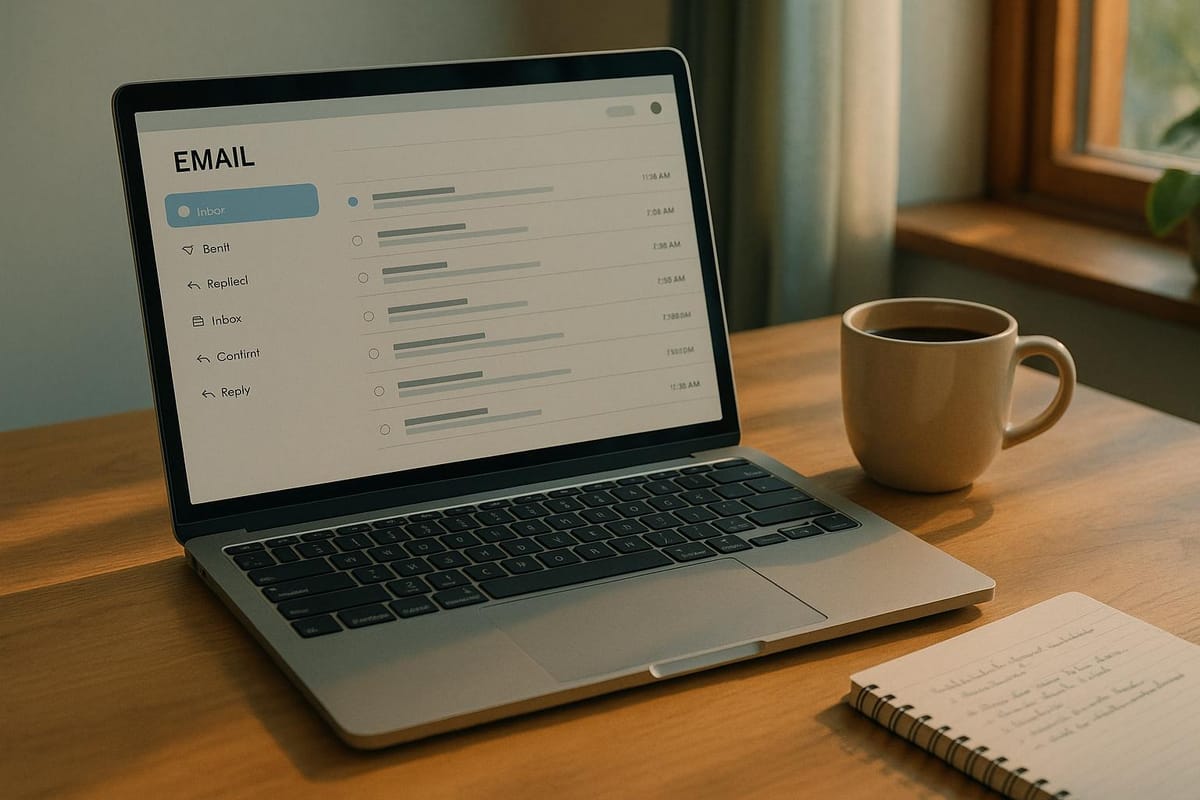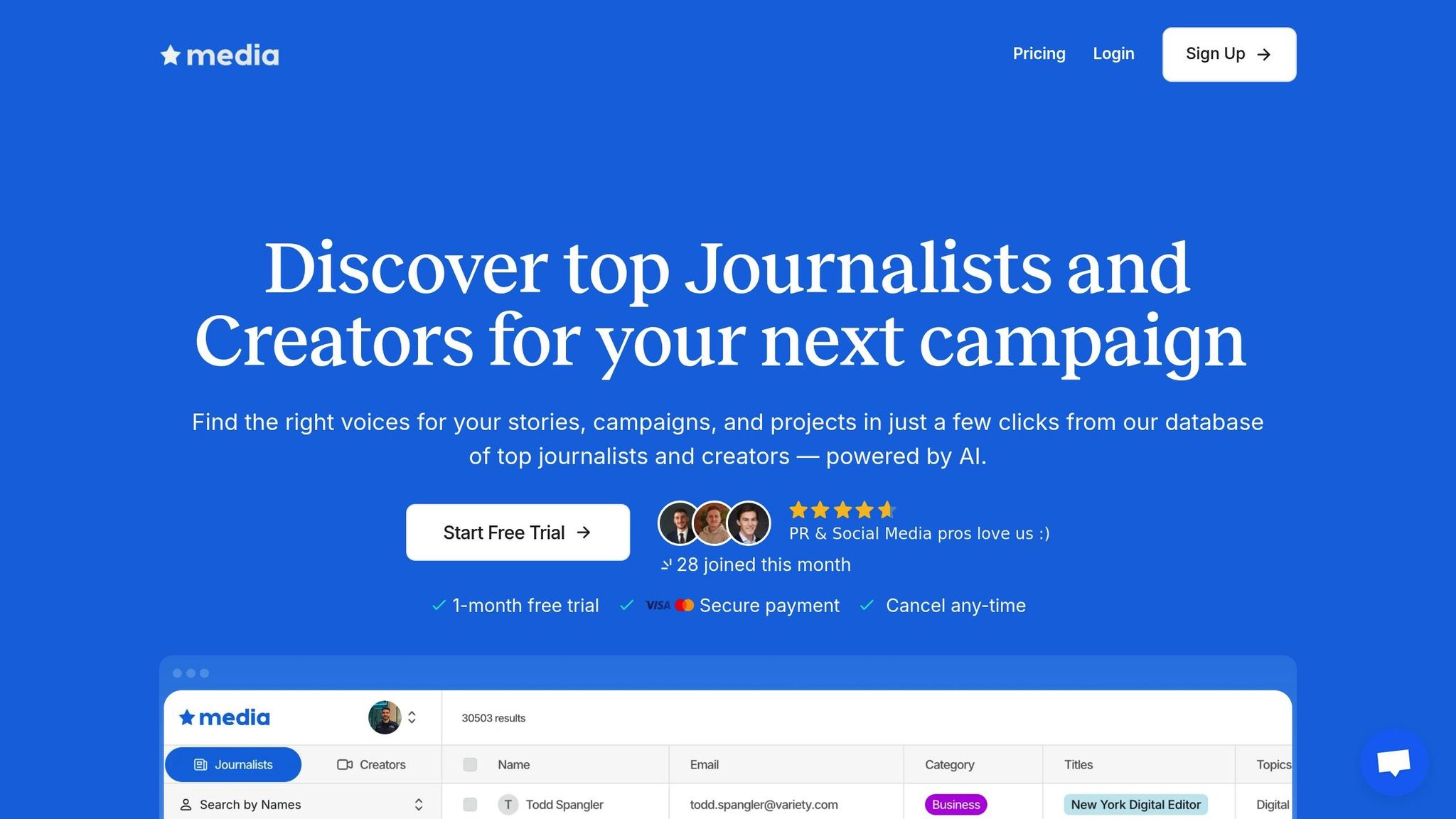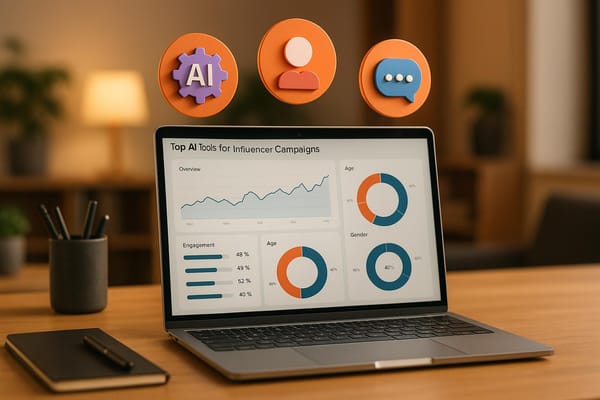Low PR Response Rates? 8 Solutions That Work
Explore effective strategies to enhance your PR outreach response rates using AI tools, personalized pitches, and data-driven insights.

Struggling to get responses to your PR pitches? You’re not alone. Journalist response rates have dropped to just 2.99% as of 2023, making it harder than ever to stand out in crowded inboxes. But there are ways to improve your success.
Here’s what works:
- Use AI tools to personalize outreach and find the right journalists.
- Time your emails strategically - Tuesday to Thursday, 10 a.m. to 2 p.m., works best.
- Automate follow-ups to stay consistent and save time.
- Leverage data to refine your campaigns and improve results.
- Build better relationships by understanding journalists’ interests and preferences.
Platforms like Media AI can help with tasks like identifying contacts, crafting tailored pitches, and tracking engagement. The key is combining smart tools with meaningful, targeted outreach.
Takeaway: Personalized, well-timed, and data-driven strategies can help your PR efforts break through the noise and boost response rates.
How to write cold emails that get responses (A 45.8% reply rate)
Solution 1: Use AI Tools for Personalized Outreach
Getting a journalist’s attention in today’s crowded inbox requires moving beyond generic, mass emails. With hundreds of pitches landing in their inbox daily, templated messages often get ignored. The answer? AI-powered personalization that makes every pitch feel like it was written specifically for the recipient.
Here’s a telling stat: 83% of personalized emails receive positive feedback, compared to the 40% neutral or negative response rate for generic, templated emails.
"The key to transforming your outreach efforts from being merely noticed to receiving responses is personalization." - Jeremy Chatelaine, QuickMail
How Media AI Helps You Find the Right Journalists

Media AI takes the guesswork out of identifying the best contacts for your story. With a database of over 30,000 journalists and creators, it uses AI to match your story angle with the most relevant individuals. Advanced filters allow you to search by topics, categories, or job titles. Need a tech journalist in San Francisco who focuses on AI startups? Media AI can find them for you in seconds.
The platform is constantly updated to ensure you’re working with accurate, up-to-date contact information. Its AI crawler works around the clock, verifying details and adding new profiles regularly.
Each journalist profile includes essential details like email addresses and social media handles. Plus, you can easily export your contact lists in formats like Excel or PDF, making campaign management a breeze. This level of precision ensures your pitches land in the right inboxes, increasing the likelihood of a meaningful response.
Why Personalization Works Better
Personalization is more than just adding someone’s name to an email. For example, 72% of journalists prefer press releases tailored to their specific interests and beats. By referencing a journalist’s recent work, you demonstrate that your pitch aligns with their focus, making it far more likely to resonate.
AI tools can take this a step further by analyzing a journalist’s past articles, tone, and areas of interest. Instead of guessing, you can craft pitches that directly align with their recent work and professional preferences.
This approach isn’t just effective in PR - it mirrors broader consumer expectations. For instance, 71% of consumers expect brands to deliver personalized experiences, and 76% feel frustrated when they don’t. In PR, the same principle applies: personalization strengthens relationships and leads to more positive responses.
"By adopting AI early, we're not only streamlining our operations, but also connecting with our media clientele more effectively." - Susan Frantz, CEO of Frantz Marketing Solutions
Solution 2: Time Your Outreach for US Media
Timing is everything when it comes to getting noticed. With the average person receiving around 120 emails daily and replying to only 25% of them, your pitch needs to land at just the right moment.
"The truth is, timing can make or break your outreach." - Katelynn Marfousi, Discontent Writer, Prezly
Most responses to digital PR emails happen within the first 6 hours. Miss that window, and your email risks being buried under a pile of unread messages. To avoid this, knowing when to hit "send" is critical.
Best Times to Send PR Emails
Understanding the work habits of Americans can give you a real edge. About 70% of people in the U.S. check their email between 5:00 a.m. and 9:00 a.m., as well as after 6:00 p.m. Interestingly, 42% of them open their email on mobile devices before even getting to work.
Here’s how you can use this knowledge to your advantage:
- Focus on sending emails from Tuesday to Thursday, with Thursday being the standout day (open rates exceed 26%). Avoid Mondays and late Friday afternoons.
- Aim to send pitches between 10:00 a.m. and 2:00 p.m.. Steer clear of the 2:00–6:00 p.m. slump when people are less likely to engage.
- Account for time zones. For instance, a 10:00 a.m. Eastern Time email might be too early for recipients on the West Coast.
- Avoid sending emails during holidays or major industry events, as these times often lead to lower response rates.
Use AI to Find the Right Recipients
Timing is only part of the equation - reaching the right people is just as important. As Collin Czarnecki, owner of Digital PR Agency Noble, puts it, "The topic and targeted vertical are critical. That's why timing and relevance are everything."
This is where AI steps in. Tools like Media AI, with its database of over 30,000 journalists and creators, use advanced analytics to identify the best recipients and the ideal times to contact them. It tracks engagement patterns, response histories, schedules, and areas of interest, helping you avoid the common mistake of sending irrelevant pitches - an issue with 73% of press releases.
Instead of blasting out mass emails and crossing your fingers, AI allows you to craft more focused, personalized outreach. In fact, well-timed emails can be nearly 40 times more effective at converting customers than social media.
AI also keeps contact data up to date in real time, so you can adapt quickly. Combining precise targeting with perfect timing ensures your pitch stands out in a journalist’s crowded inbox.
Solution 3: Automate Your Follow-Up Emails
Did you know that 80% of sales require at least five follow-ups, yet 44% of professionals stop after just one? This same tendency to give up too soon can derail PR campaigns, where missed responses often come down to inconsistent follow-ups.
The numbers tell the story. Campaigns that include follow-ups achieve an 85% higher reply rate compared to single-email efforts. Even better, the second email in a follow-up sequence boasts a 79% higher open rate than the first. Despite this, many still rely on manual follow-ups, which are time-consuming and prone to neglect.
"AI has the power to fully automate follow-ups, personalize them with relevant data points, optimize their timing, and improve overall effectiveness." - Eugene Suslov
Automating your follow-up process not only saves time but also lets you focus on crafting stronger pitches and building relationships. Instead of worrying about who needs a follow-up and when, you can dedicate your energy to higher-value tasks.
Set Up Automated Follow-Up Sequences
Automation is a game-changer, but the how matters just as much as the what. Timing and added value are critical for effective follow-ups. Bandita Deb from Lenovo ISG's PR and Communications team emphasizes this point:
"I believe the key to effective follow-up is timing and relevance. After sending out a press release or story pitch, it's crucial to follow up within 24-48 hours while the information is still fresh."
With tools like Media AI, you can create automated follow-up sequences that align with these principles. For example, you can schedule follow-ups to go out 24 hours after the initial email, with subsequent messages spaced 2-3 days apart. Here’s a suggested structure:
- First Follow-Up (24-48 hours later): Reference your original pitch and include a fresh data point or angle.
- Second Follow-Up (2-3 days later): Provide extra value, such as updated insights or exclusive access.
- Final Follow-Up (1 week later): Offer one last unique takeaway, then wrap up the sequence.
This approach ensures your messages are timely and valuable, even when you’re managing multiple campaigns or working on tight deadlines.
Track Responses to Improve Follow-Ups
Once your follow-ups are automated, tracking their performance is essential. Without measurement, automation risks becoming little more than spam. The real advantage lies in using data to refine your strategy.
Media AI makes this easy by monitoring open rates, response patterns, and engagement trends. For instance, open rates tend to peak on Day 1 at around 38% after the initial email, while the reply rate for the second email is 66% lower than the first follow-up. These insights help you fine-tune your approach.
The platform's AI also learns from this data, identifying which subject lines work best and adjusting send times based on recipient behavior. You can even personalize follow-ups with dynamic fields, tailoring your message to resonate more deeply.
"Automated follow-ups increase efficiency: Save time and boost productivity by automating repetitive tasks in your sales process." - Attention.com
Another benefit? Preventing over-communication. If someone hasn’t engaged after three follow-ups, the system can automatically remove them from your sequence. This not only protects your sender reputation but also shows respect for the recipient's time. By continuously analyzing and adjusting, Media AI ensures your PR outreach stays effective and efficient at every step.
Solution 4: Use Data to Improve Your Campaigns
Did you know that while 78% of CMOs demand measurable PR value, only 34% of teams actually have the right data tools to deliver it? This gap isn’t just about tracking results; it’s about understanding what drives them. Data doesn’t just tell you what happened - it helps you predict what will work.
Data-driven PR can uncover winning strategies, fine-tune your messaging, and even anticipate how journalists will respond. The stats back it up: in 2023, 91.9% of organizations reported measurable value from their data and analytics efforts. And with journalists responding to only 3% of pitches, precision is everything. Every email should be guided by data. Knowing which subject lines grab attention, the best times to send, and which journalists are engaging with your content can make all the difference. Media AI’s analytics dashboard is built to turn these insights into action.
Track Open Rates and Response Data
Media AI’s dashboard offers a deep dive into the metrics that matter. It tracks open rates, click-through rates, and response patterns, giving you a clear view of what’s working - and what’s not.
Industry benchmarks can help you measure your performance. For example, open rates generally range from 17–28%, while click-through rates typically fall between 2–5%, depending on the industry. Here’s how some key sectors stack up:
| Industry | Open Rates | Click-Through Rates |
|---|---|---|
| Education | 28.5% | 4.4% |
| Financial Services | 27.1% | 2.4% |
| IT/Tech/Software | 22.7% | 2.0% |
| Media & Entertainment | 23.9% | 2.9% |
Media AI goes beyond basic metrics by analyzing factors like email timing, subject line effectiveness, and format performance. This detailed data doesn’t just show you what happened - it helps explain why it happened.
The platform also tracks sentiment and response quality. After all, a high open rate means little if the responses are negative or if journalists are asking to be removed from your list. With sentiment analysis, Media AI helps you maintain strong relationships while driving better results.
Apply Data Insights to Future Campaigns
The real power of data lies in using it to improve future efforts. Media AI leverages historical data to refine your campaigns, giving you a clear edge. Its machine learning algorithms identify patterns across your past campaigns, uncovering insights that might not be immediately obvious.
Simon Bacher, CEO of the Ling App, shared how data reshaped his company’s PR strategy:
"The messaging of our entire PR efforts was hinged on what our customers were using our app for. Initially, we were simply trying to push out feature after feature, thinking that's what our customers wanted. If we didn't analyze user intention and ignored data, we would still be doing this instead of refining and focusing our efforts on user experience."
The results speak for themselves. A tech startup, TechForward, saw incredible success by adopting a data-driven PR approach. Within just a few months, they increased media coverage by 45%. Their AI-powered email campaigns boosted open rates by 30%, and personalized pitches led to a 25% jump in journalist responses.
Media AI also helps you identify and prioritize media contacts who consistently engage with your content. And during high-stakes moments, like a crisis, real-time monitoring becomes invaluable. Media AI’s real-time feedback allows you to adjust your strategy immediately instead of waiting until the campaign ends.
Solution 5: Build Better Media Relationships with AI
Improving PR response rates often comes down to building stronger media relationships, and AI can play a key role in making that happen. To foster these connections, you need to identify the right journalists and truly understand their work. Right now, there’s a big gap to fill - 75% of journalists report that fewer than a quarter of the pitches they receive are relevant to their beat. This is where AI’s precision can make a difference.
The key to success lies in targeted outreach. AI tools can sift through massive amounts of data, including media mentions, social media activity, and audience behavior, to help PR teams figure out who to contact and how to approach them. When you know a journalist’s interests, recent work, and preferred communication style, your outreach becomes more personal and effective - no more impersonal mass emails.
The results back this up. AI-driven tools have been shown to increase media coverage by 25% and boost social media engagement by 40%. Even better, 65% of journalists appreciate regular check-ins from PR contacts who consistently offer value. AI doesn’t just help you find the right people; it helps you nurture relationships that matter. Let’s break this down further.
Find Journalists Who Match Your Story
AI can take the guesswork out of finding the right journalists. For example, Media AI’s database includes over 30,000 journalists and uses AI-powered prospecting to match your story with the right contacts. By scanning keywords across websites, the platform identifies journalists and influencers who are genuinely aligned with your narrative.
Beyond just names, Media AI analyzes recent articles, beat coverage, and engagement trends to recommend journalists who focus on your specific niche - whether it’s AI startups, enterprise software, or another area. You can also refine your search with advanced filters, narrowing down contacts by industry, publication type, audience size, or location. This ensures your outreach is laser-focused, whether you’re launching a fintech product or announcing a healthcare partnership.
This targeted approach can yield impressive results. One PR manager boosted coverage by 40% by creating a "preview program" that gave select journalists early access to company news under embargo. When you know exactly who covers your beat and what they care about, you can create exclusive opportunities that deepen relationships over time.
Tailor Pitches to Each Journalist's Style
Generic pitches are a surefire way to lose a journalist’s interest. Media AI helps solve this by tailoring pitches to match each journalist’s unique style. The platform provides insights into what topics a journalist covers, their preferred angles, and the types of sources they often quote.
For instance, if a journalist leans toward data-driven stories, the AI might suggest leading your pitch with compelling statistics. If they favor human interest pieces, it could recommend starting with a customer story or a quote from your company’s founder. This kind of personalization shows that you’ve done your homework and understand their editorial preferences, making your outreach more effective.
"PR is still about relationships, storytelling, and trust."
That insight from Molly Bell, Account Director for Consumer & Travel, captures why AI-driven personalization works so well. AI doesn’t replace the human element - it enhances it by ensuring your interactions are relevant and valuable.
Journalists value genuine relationships. Even the most data-driven pitch won’t land without trust and connection. AI equips you with the tools to build those connections, but it’s up to you to maintain them. By using AI insights to understand a journalist’s work and consistently offer value, you can transform occasional outreach into meaningful, long-term relationships.
Media AI also helps you stay in touch by tracking journalist preferences and past interactions. It can remind you to congratulate them on recent stories, share industry insights, or offer early access to new research or product launches. These thoughtful, AI-guided touchpoints - delivered with genuine human interest - are what turn one-off pitches into lasting professional partnerships.
Conclusion: Improve Your PR Response Rates with AI
Struggling with low response rates? These eight AI-driven strategies can help breathe new life into your PR outreach. By using tools like AI-powered personalization, smart timing, automated follow-ups, and data analytics, PR professionals can stand out in the sea of pitches journalists receive every day. The goal? To turn those generic, mass emails into campaigns that are sharply targeted and backed by data.
AI can help you craft personalized messages, time your outreach perfectly, and gain insights from data to fine-tune your approach. Keeping tabs on open rates, response rates, and follow-up engagement allows you to continuously improve your strategy and increase your chances of success.
Platforms like Media AI, with its database of over 30,000 journalists and creators, give US-based PR teams the tools they need to make these strategies work. Features such as advanced filtering and easy export options simplify the process - from finding the right contacts to tracking how well your campaign performs.
But here’s the real secret: long-term success comes from building genuine relationships with journalists. Outreach shouldn’t feel transactional. By combining these AI-driven approaches with a sincere effort to connect, PR professionals can boost response rates, strengthen media relationships, and enhance brand visibility - all while staying ahead in the ever-changing PR landscape.
FAQs
How can AI tools help create more personalized PR pitches to boost response rates?
AI tools can make PR outreach much more effective by helping you create personalized pitches that truly connect with individual journalists. These tools dig into details like a journalist's preferences, past interactions, and the topics they typically cover. The result? Messages that feel relevant and are more likely to grab their attention.
On top of that, AI can identify the best times to send your pitch and even recommend which journalists are most likely to engage with it. This data-driven strategy doesn’t just save you time - it ensures your outreach is more impactful, helping to build stronger media relationships and boosting your chances of getting a response.
When is the best time to send PR emails to maximize engagement with journalists?
The best time to send PR emails is typically between 10:00 a.m. and 2:00 p.m., from Tuesday to Thursday. During this period, journalists are more likely to have the time to check their inboxes and consider pitches, as their schedules are less chaotic and they’re actively planning their stories.
It’s wise to steer clear of early Monday mornings and late Friday afternoons. These times often coincide with the rush to start the week or the scramble to wrap things up before the weekend. By aiming for mid-morning or early afternoon in the middle of the week, you can boost the likelihood of your email standing out and getting a prompt response.
Why is automating follow-up emails important for boosting PR campaign response rates, and how can it be done effectively?
Automating follow-up emails is a game-changer for boosting response rates in PR campaigns. It ensures you stay in touch with journalists and influencers consistently, keeping your pitch fresh in their minds and laying the groundwork for stronger professional connections over time.
To make this work effectively, craft personalized, timely messages that genuinely connect with your audience. Schedule automated follow-ups at well-thought-out intervals so they feel natural and engaging instead of mechanical. This approach not only saves time but also simplifies your outreach efforts, helping you maintain contact without overwhelming your recipients - ultimately increasing the likelihood of a response.





